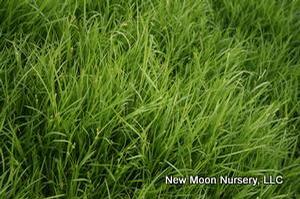Printed at http://www.newmoonnursery.com/index.cfm/
Carex amphibola
Creek sedge
Native to North America
FIRST IMPRESSIONS: Carex amphibola is a robust perennial sedge that grows in compact mounds. The narrow leaves are shiny, upright and often semi-evergreen. In late spring green scaly flower spikes top the gracefully shaggy foliage. This is a sedge for a woodland or shade garden with moist or wet soil.
HABITAT & HARDINESS: Carex amphibola is native to eastern North America from Quebec to Texas and from New Hampshire to Georgia.
Plants are indigenous to deciduous floodplain forests, mesic forests with acidic loamy soils, flatwoods, slopes above streams or creeks, seeps, lake shores and moist upland deciduous woodlands.
Hardy from USDA Zones 3-9.
PLANT DESCRIPTION: Carex amphibola is a vigorous clump forming sedge with a mounding or fountain like habit.
The arching glossy leaves are semi-evergreen in warm climates and deciduous further north. Leaves are about a foot long and less than 1/8” wide
In late spring this sedge bears several elongated green flower clusters that are distributed along the culm. The lower spikes are female or pistillate and the terminal spike is male or staminate.
Plants are 12-18” tall with an equal spread.
CULTURAL & MAINTENANCE NEEDS: Carex amphibola thrives in shaded sites with deep moist soil or in good garden soil. Plants will tolerate sun but may need some irrigation during summer.
This sedge will self-seed but since it is not an aggressive seeder this is usually not a problem.
Plants are pest resistant and unpalatable to deer and other herbivores.
LANDSCAPE USES: Carex amphibola is a valuable Groundcover or Edging Plant for a Shade Garden. This sedge is useful in meadows and is a good component for a Grouping or Mass Planting. Plants provide Erosion Control and Winter Interest and are appropriate for Deer Resistant Plantings, Low Maintenance Plantings, Restoration Projects and Wildlife Gardens. Carex amphibola is a great native substitute for the popular Asian groundcovers Liriope muscari and Ophiopogon japonicus.
COMPANION & UNDERSTUDY PLANTS: Try pairing plants with Phlox divaricata, Chrysogonum virginianum, Heuchera americana 'Dales Strain', and Polystichum acrostichoides.
Carex laxiculmis is similar in appearance and cultural needs and can be substituted if needed.
TRIVIA: Plants host some types of Skipper caterpillars and seeds are eaten by turtles.
Over 1500 species of Carex grow in a variety of habitats (often moist to wet areas) throughout the world. Identification of individual species can be very difficult. Generally the plant must be in bloom and a magnifying glass must be nearby.
The perigynium is a distinguishing feature of Carex spp. This is a bag-like bract that encloses the pistillate flowers. The sac-like structure persists after fertilization and surrounds the resulting fruit which is a one seeded achene. The shape, surface characteristics and vestiture of the perigynium are important identification characteristics for Carex spp.
To the uninitiated, Carex spp. seem almost undistinguishable from many grasses. Both have fibrous roots, narrow linear leaves with parallel veins and usually have underground rhizomes. Carex spp. are perennials with triangular stems. Grasses usually have swollen nodes or joints and hollow stems and Carex spp. have neither. Botanists believe that Carex spp is actually more closely related to Juncus spp. than to the grasses.
Height:
12-18 inSpread:
12-18 inSpacing:
15-24 inUSDA Hardiness Zone:
3-9Bloom Color:
GreenCarex amphibola Characteristics
Attracts Wildlife
- Pollinators
- Songbirds
Exposure
- Partial Shade to Full Shade
Deer Resistant
- Deer Resistant
Flowering Months
- June
- May
- April
- March
Foliage Color
- Green
Grass Season
- Cool Season Grass
Groundcover Foot-Traffic Tolerances
- Light
Lawn Replacement or Groundcover
- Groundcover
- Lawn Replacement
Season of Interest (Foliage)
- Summer
- Spring
- Winter
- Fall
Soil Moisture Preference
- Moist to Wet
Interesting Notes:
For more information on this plant, visit the USDA PLANTS Database: http://plants.usda.gov/java/profile?symbol=CAAM8

